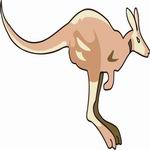- They live in areas of scrubland or open forest with stretches of dry
grass, widely spaced patches of bushes and clumps of trees.
- Their main foods are grass and the shoots of young plants. Like many
grass eaters they re-chew and re-digest their food by
- chewing the cud".
- Wallabies are sometimes killed and eaten by dingos.
- After a pregnancy lasting just one month, the female wallaby gives
birth to a tiny hilpless baby which crawls into a special pouch and
latches on to a teat. It grows and develops in the pouch for for about
8 months, but will keep coming back to mum for a drink of milk for longer
- sometimes trying to climb back into the pouch! By this time she will
probably have another baby in her pouch, so she must be very firm with
her older youngster.
- Scientists have discovered that, amazingly, wallabies can produce
two different kinds of milk at the same time: one for the tiny baby
and another, richer blend for its big brother or sister!
- Wallabies are mainly nocturnal, coming out to graze in the late afternoon
until early the next morning.
- During the day they rest in clumps of trees or bushes.
- The wallaby's large, powerful tail is used for balance when hopping
or grazing.
- A tail-less wallaby would probably topple over onto its nose!
- Large ears that can be swivelled round sideways give the wallaby
an excellent sense of hearing.
- Its sense of smell is good, too, but its eyesight is thought to be
quite poor.
|


